Creating a pollinator-friendly garden layout is essential for supporting biodiversity. I've discovered the beauty of designs like cottage gardens and wildflower meadows, which combine diverse plants to attract bees and butterflies. Vertical gardens and raised beds also provide space-efficient habitats, while edible environments supply essential nectar. With thoughtful plant arrangements and strategies, we can create a vibrant ecosystem. Inspired by the art of gardening, I hope you'll explore these stunning layouts and their complex benefits.
Quick Takeaways
- Cottage gardens create inviting spaces with layered plantings, attracting diverse pollinators through colorful and textured native plants.
- Wildflower meadows provide low-maintenance, vibrant habitats that support various pollinator species with their organic growth patterns.
- Vertical gardens maximize space and offer continuous nectar sources, featuring pollinator-friendly plants in modern, wall-mounted designs.
- Raised bed sanctuaries incorporate native perennials, enhancing biodiversity while providing essential shelter and food for pollinators.
- Sustainable practices like xeriscaping conserve water and support pollinator habitats through native plants that require minimal irrigation and maintenance.
Cottage Garden Design
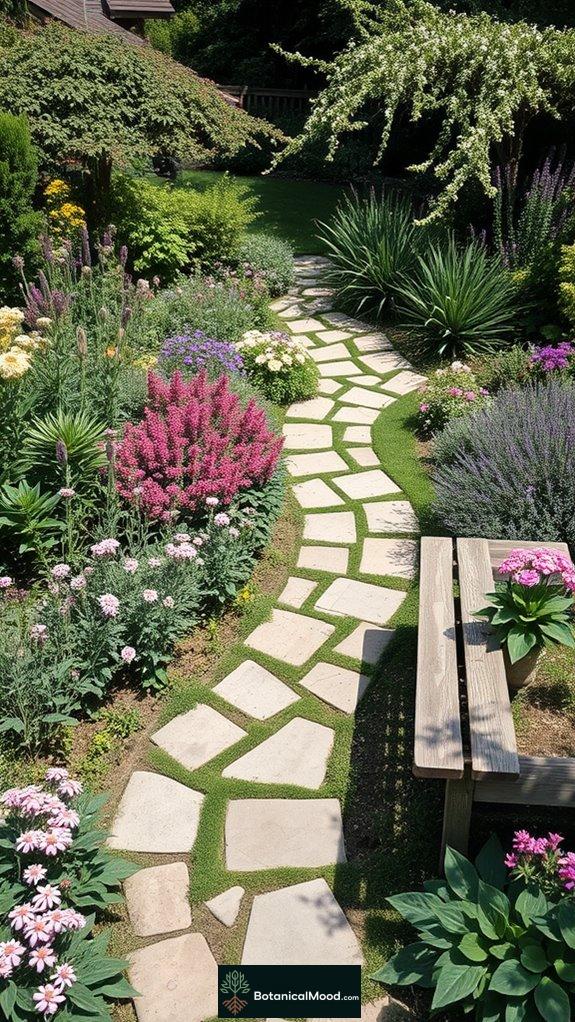
Cottage garden design embodies a charming blend of beauty and biodiversity, creating a welcoming space for both people and pollinators alike.
To craft this enchanting environment, focus on cottage garden essentials like layered planting and informal layouts. Selecting pollinator plants such as bee balm, lavender, and coneflower guarantees a vibrant palette that attracts butterflies and bees. Native plants provide optimal nutrition for local pollinators, ensuring they thrive in your garden. Incorporating native flowering plants into your design promotes a sustainable habitat that supports various pollinator species.
Focus on layered planting and informal layouts to create a vibrant cottage garden that attracts essential pollinators.
I've found that mixing textures and colors not only enhances visual appeal but also supports diverse ecosystems. By embracing a forgiving nature, we allow gardens to flourish in delightful chaos, inviting exploration.
This philosophy is what inspired me to create Botanical Mood, merging beauty with ecological responsibility.
Wildflower Meadow Layout

Creating a wildflower meadow layout transforms your garden into a vibrant tapestry of colors and textures, harmonizing nature's beauty with ecological function.
Vertical Garden Pollinator Habitat

While vertical gardens may seem like a modern trend, they offer an incredible opportunity to support pollinators in even the most confined spaces.
By thoughtfully selecting pollinator plants like Black-eyed Susans and Milkweed, I create vibrant vertical garden aesthetics that attract bees and butterflies.
Thoughtfully chosen pollinator plants like Black-eyed Susans and Milkweed create stunning vertical gardens that invite bees and butterflies.
I guarantee a variety of blooms throughout the seasons, providing a continuous nectar source.
Using wall-mounted planters and trellises, I maximize space while enhancing beauty.
With careful water management and organic pest control, I maintain a thriving habitat.
This innovative approach not only promotes biodiversity but also inspires others to appreciate nature's wonders, which is why I created Botanical Mood.
In addition, pollinator-friendly plants are essential components that help sustain local ecosystems and increase biodiversity.
Raised Bed Pollinator Sanctuary

Raised beds can transform any garden into a thriving sanctuary for pollinators, offering both beauty and functionality.
With innovative raised bed design, I strategically place a diverse mix of native perennials and annuals that bloom throughout the season, ensuring an abundant food source. Layered planting maximizes visibility, while repeated color patterns attract bees and butterflies effectively. Implementing companion planting strategies can further enhance the ecosystem by promoting beneficial relationships among plants.
Creating pollinator shelter is essential; I leave bare ground for nesting and include a shallow water feature for hydration.
This approach not only enhances biodiversity but also reflects my passion for nurturing nature, which inspired me to create Botanical Mood, a space dedicated to pollinator support.
Edible Landscape for Bees

An edible environment not only enhances the aesthetic appeal of your garden but also serves as an important habitat for bees and other pollinators.
By incorporating bee-friendly herbs like mint and chives alongside vibrant flowering vegetables such as cucumbers and pumpkins, you'll create a lush, inviting space.
Incorporating bee-friendly herbs and vibrant flowering vegetables creates a lush, inviting garden that nourishes both us and pollinators.
These plants not only provide nourishment for us but also supply vital nectar and pollen for our buzzing friends.
Strategically grouped plantings guarantee abundant blooms throughout the growing season, supporting diverse pollinator populations.
Additionally, incorporating native flowering plants can further boost the health of local bee populations.
I created Botanical Mood to inspire innovative designs that celebrate both beauty and biodiversity in our gardens.
Pollinator Pathways

Creating a vibrant pollinator-friendly garden involves more than just planting a few flowers; it's about establishing interconnected spaces that serve as lifelines for our buzzing allies.
By implementing effective pollinator corridor design, I guarantee these pathways connect diverse habitats, rich in native plants that bloom throughout the seasons.
Utilizing habitat connectivity strategies, I create safe corridors filled with herbs and flowers like lavender and coneflowers, which attract and nourish pollinators.
I maintain these paths sustainably, avoiding pesticides and promoting healthy soil, thereby fostering an ecosystem that supports both beauty and biodiversity.
Incorporating native bee and butterfly plants into the garden layout enhances the overall appeal and effectiveness of these spaces.
Join me in celebrating the harmony of nature through thoughtful garden design.
Butterfly Garden Nook

A butterfly garden nook transforms a small space into a vibrant sanctuary, inviting these delicate creatures to flutter through your yard. By understanding butterfly behavior and nectar preferences, I've designed a fascinating area that thrives on diversity.
I guarantee my garden receives 6-8 hours of sunlight, with a mix of flowers that vary in shape, color, and size. I include host plants alongside nectar-rich varieties like milkweed and butterfly bush. To support a broader range of species, I also incorporate plants that attract native pollinators, which are essential for maintaining a balanced ecosystem.
To enhance the experience, I've added light-colored rocks for sunbathing and shallow water sources. This nook not only attracts butterflies but also enriches the biodiversity in my garden.
Rain Garden for Pollinators
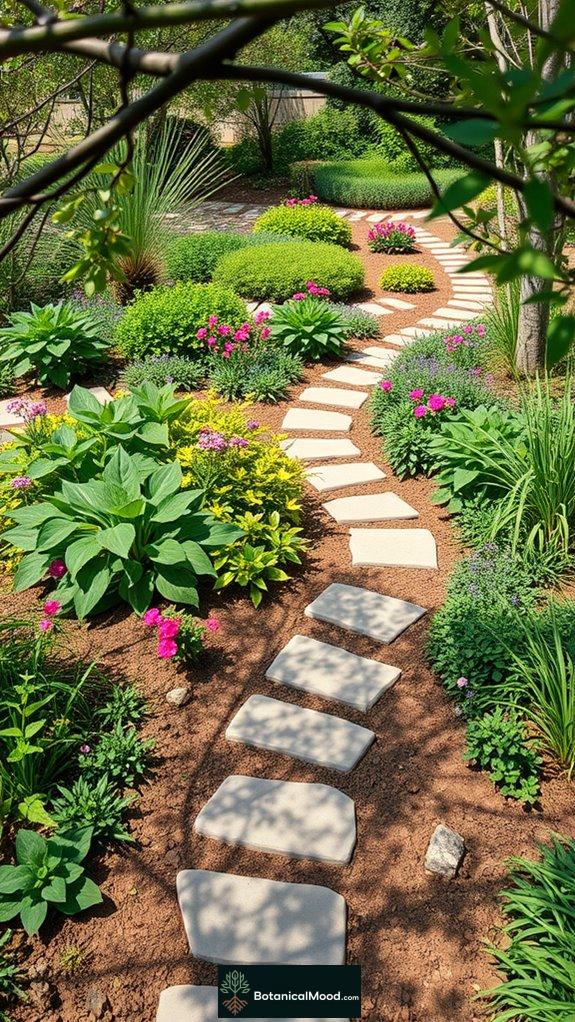
While my butterfly garden nook serves as a haven for fluttering beauty, incorporating a rain garden enhances the overall ecosystem by inviting a different but equally important group of pollinators.
In my rain garden design, I've selected moisture-loving native plants like Swamp Milkweed, which not only thrive in the damp conditions but also create a vibrant pollinator habitat.
These plants provide essential nectar throughout the seasons, supporting bees and butterflies alike.
Through careful placement and layered planting, I've transformed an ordinary runoff area into a stunning ecological feature, showcasing how innovative gardening can harmonize beauty with biodiversity. Additionally, selecting native drought-resistant plants helps ensure the garden's sustainability even during dry spells, making it a resilient choice for coastal landscapes.
Xeriscape Pollinator Zone
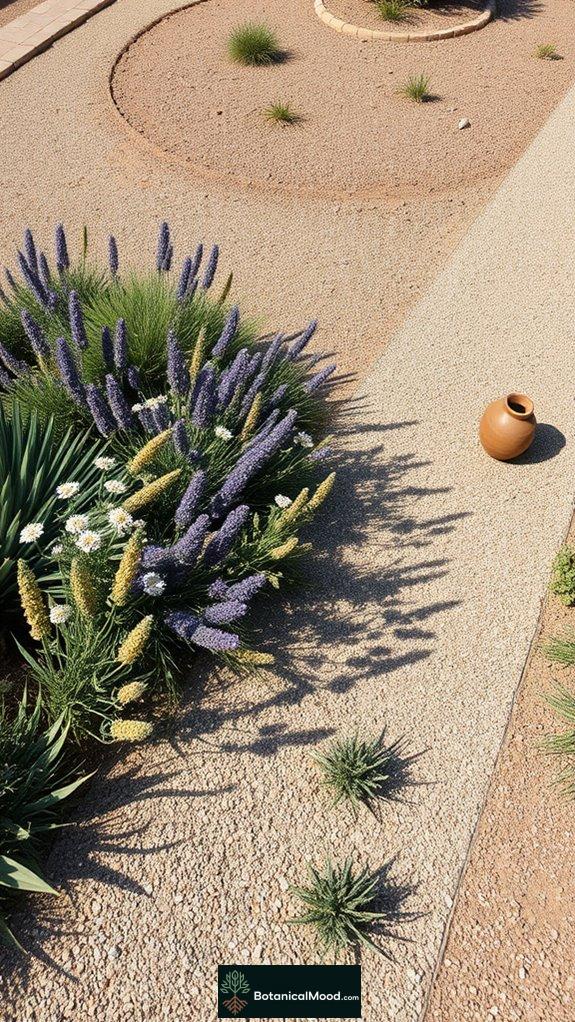
Incorporating xeriscape principles into my garden design not only conserves water but also creates a vibrant sanctuary for pollinators. The xeriscape benefits are immense, especially when I select native plants like Agastache and Salvia, which thrive with minimal irrigation. These plants provide diverse blooming periods, ensuring a constant nectar source year-round. By minimizing mulch, I foster ground-nesting habitats for bees, while hardscaping elements enhance water conservation. Implementing water-wise garden planning strategies further optimizes resource use and supports sustainable gardening practices. The aesthetic appeal of colorful flowers paired with durable materials makes my garden a visual delight, showcasing the native plant advantages and promoting biodiversity, something I truly cherish and encourage through my website, Botanical Mood.
Container Garden for Small Spaces

Creating a pollinator-friendly container garden in small spaces can be both rewarding and visually stunning.
I love selecting compact containers that not only support vibrant plants but also enhance container aesthetics. Make sure your containers have proper drainage to keep roots healthy, and choose materials that suit your style, like ceramic or terracotta.
Selecting stylish, compact containers with proper drainage enhances both plant health and garden aesthetics. Choose materials that reflect your taste.
Incorporating dwarf varieties like lavender and bee balm attracts pollinators while maximizing space efficiency. Mixing colors and textures creates visual interest, while staggered bloom times guarantee continuous nectar availability. Additionally, native plants are excellent choices as they provide the best resources for local pollinators.
Regular watering and avoiding chemicals are essential for pollinator maintenance, allowing us to enjoy a thriving ecosystem in even the smallest gardens.
Herb Spiral for Beneficial Insects

After enjoying the charm of a container garden, I find myself drawn to the innovative design of an herb spiral, which offers a unique way to attract beneficial insects while maximizing space.
This dynamic structure not only enhances biodiversity but also creates various microclimates for diverse plant growth.
Here are three key benefits of an herb spiral design:
- Compactness: It packs a variety of herbs into a small footprint.
- Microclimates: Different height levels provide unique conditions for plants.
- Pollinator Attraction: Selecting bee-friendly herbs like chamomile and dill guarantees a thriving ecosystem.
Additionally, incorporating diverse flowering plants within the herb spiral can further support the overall health of your pollinator-friendly garden.
Creating a sustainable garden, like I envisioned with Botanical Mood, starts here.
Pollinator-Friendly Rock Garden
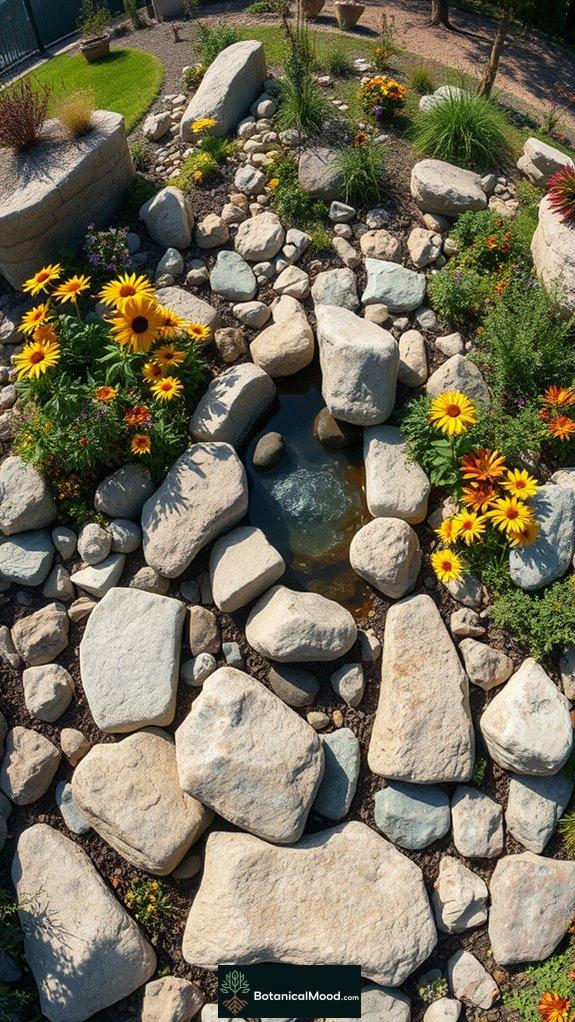
A pollinator-friendly rock garden can be a stunning addition to your scenery, effortlessly merging beauty with ecological purpose.
By incorporating native plants like black-eyed Susans and butterfly weed, I create habitats that attract pollinators while minimizing rock garden maintenance.
Incorporating native plants like black-eyed Susans and butterfly weed fosters pollinator habitats while simplifying rock garden care.
Using various rocks adds depth, enhancing the visual appeal and providing shelter for wildlife.
I also consider adding water features, which boost biodiversity and invite birds.
The balance of colors and textures captivates the eye, while supporting an enriched ecosystem.
This innovative design reflects my passion for nature, which is why I created Botanical Mood—to inspire others to cultivate vibrant, sustainable gardens.
Forest Garden With Native Plants

Forest gardens, rich with native plants, serve as an enchanting sanctuary for both wildlife and people.
I've found that creating a forest ecosystem not only beautifies my space but also enhances biodiversity.
Here are three key benefits I've discovered:
- Increased Biodiversity: Layered structures support a variety of native species, attracting diverse wildlife.
- Pollinator Support: With a mix of deciduous and fruit-bearing plants, these gardens provide essential food sources for pollinators throughout the seasons.
- Low Maintenance: Utilizing natural processes for soil health and pest control means less effort for sustainable beauty.
This concept inspired me to create Botanical Mood, celebrating nature's complex designs.
Community Pollinator Garden

Creating a community pollinator garden can transform an ordinary space into a vibrant haven for both nature and neighbors. Through community involvement, we can unite passionate individuals to design a garden that celebrates biodiversity.
Effective garden planning begins with selecting native plants that attract local pollinators, ensuring a diverse array of nectar sources. Layered plantings create visual interest, while staggered bloom times provide continuous food for bees and butterflies throughout the seasons.
Involving local nurseries fosters partnerships, and I believe that education and outreach are essential. By sharing knowledge, we cultivate not just plants, but a thriving community dedicated to pollinator conservation.
Succession Planting for Year-Round Habitat

While planning a garden, I find it essential to think about how to provide a year-round habitat for pollinators through succession planting.
This technique not only supports seasonal blooms but also enhances pollinator education by showcasing diverse plant life.
Here are three key strategies I use:
- Diverse Plant Selection: Incorporate a variety of native plants that bloom at different times.
- Staggered Planting: Plant portions of the same crop at intervals to guarantee continual blooms.
- Soil Health Management: Rotate crops and enrich soil to create a thriving environment for both plants and pollinators.
Pollinator Habitat Arrangement Strategies

As I design pollinator habitats, I realize that thoughtful arrangement plays an essential role in attracting and supporting these important creatures.
By strategically locating pollinator resource locations near diverse crop fields, I enhance their access to food. I also prioritize minimizing chemical exposure by situating habitats away from pesticide-prone areas.
Utilizing habitat clustering techniques, I create larger, round spaces that reduce edge effects, thereby fostering a vibrant ecosystem.
Incorporating vegetative buffers also guarantees protection from chemical drift, while promoting connectivity between habitats.
This careful planning not only supports pollinators but also enriches the overall beauty of my garden, inspiring my work at Botanical Mood.
Pollinator-Friendly Plant Grouping

Grouping plants in your pollinator-friendly garden can greatly enhance both the efficiency of foraging and the visual appeal of your space.
By focusing on strategic arrangements, I've discovered a few key principles that can make a significant difference:
- Cluster Size: Aim for clusters about a meter wide to attract attention.
- Single-Species Groupings: Many pollinators exhibit flower constancy, so they thrive on focused species.
- Color and Shape Diversity: Different blooms attract diverse pollinators, enriching plant diversity.
With these strategies, you'll create a vibrant, sustainable environment that supports pollinators, inspiring my passion behind Botanical Mood.
Sustainable Native Garden Blueprint

Creating a sustainable native garden requires a thoughtful approach that goes beyond just selecting the right plants.
I've found that incorporating native plant benefits considerably reduces maintenance, thanks to their deep roots that minimize erosion and weed growth.
Incorporating native plants significantly lowers maintenance by leveraging their deep roots to control erosion and suppress weeds.
By blending bold and fine-textured plants, like *Silphium laciniatum* and *Coreopsis sp.*, I create visually stunning and ecologically rich spaces.
These gardens support local biodiversity, providing essential habitats for wildlife while reducing the need for chemical pesticides.
Through my website, Botanical Mood, I aim to inspire others to explore sustainable gardening practices that beautify our world and foster a deeper connection to nature.
Strategic Plant Placement Benefits
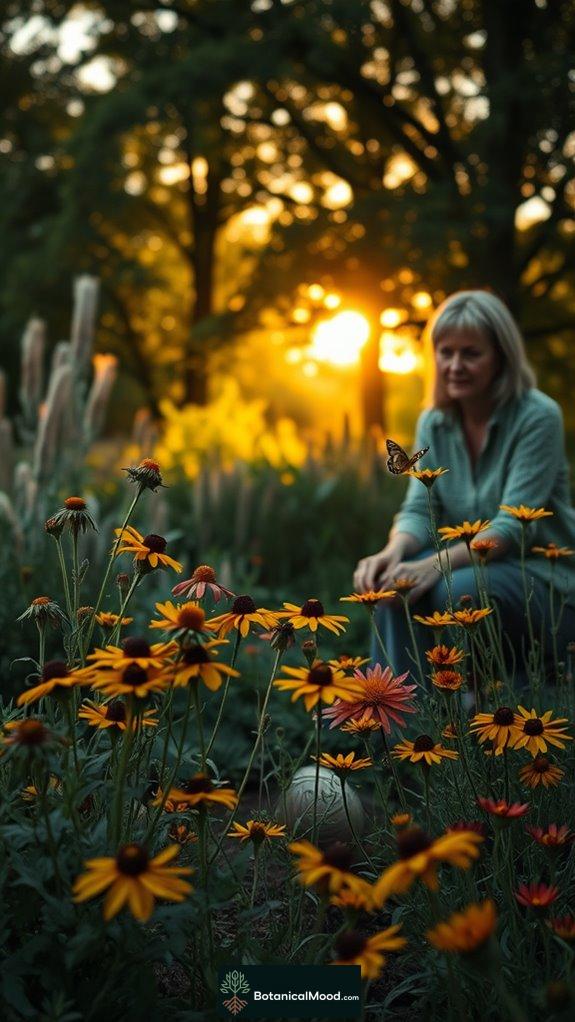
When designing a pollinator-friendly garden, the strategic placement of plants can greatly enhance not only the beauty of the space but also its ecological value.
By focusing on three key factors, we can maximize our garden's impact:
- Native Plant Selection: Native plants attract local pollinators, supporting habitat restoration and plant diversity.
- Seasonal Bloom Variety: A range of blooming times keeps pollinators nourished year-round.
- Mass Planting Technique: Clustering similar plants reduces travel distances for pollinators, enhancing both aesthetics and functionality.
Through these practices, I aim to inspire others to create vibrant ecosystems that thrive and contribute to our shared environment.
References
- https://www.monrovia.com/be-inspired/easy-pollinator-garden-ideas.html
- https://harvestsavvy.com/pollinator-friendly-garden/
- https://www.monrovia.com/be-inspired/find-your-pollinator-garden-style.html
- https://savvygardening.com/pollinator-garden-design/
- https://www.tangledgardens.com/journal/h7ydqdht5j5qgbad5qvtxs7m4tb1x4
- https://www.finegardening.com/article/how-to-design-a-stylized-meadow-garden
- https://createsolutions.tufts.edu/wp-content/uploads/2021/08/CREATE_Pollinators_Murphy_Crone.pdf
- https://harmonyinthegarden.com/2023/06/designing-a-modified-meadow/
- https://gardenmoxie.com/build-a-remarkable-pollinator-friendly-flower-garden/
- https://www.fnps.org/assets/pdf/palmetto/36-2_Huegel_Meadows_2.pdf

Leave a Reply